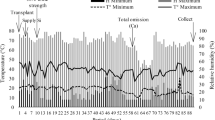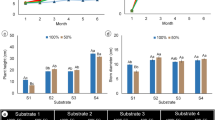Abstract
RESULTS of earlier work on the goitrogenous properties of plants1–3 supported the assumption that goitrogenous activity of vegetable foodstuffs, particularly that of Brassica species, depends to a large extent on the content of sulphur compounds as goitrogenous substances. Therefore, in an attempt to supply experimental evidence for the relationship between cabbage goitrogenicity and the intake and rate of utilization of sulphates from nutrient environment, cabbage (Brassica oleracea, var. capitata, subsp. Amager) was cultivated in pure silica sand (SiO2), in vegetation pots, by means of nutrient solutions in which only the sulphate content was made to vary. The results of the first experiment in this series had confirmed the above assumption, namely, that goitrogenous activity of the cabbage increased in relation to the sulphate content in the nutrient solution4,5. However, efforts to grow cabbage without goitrogenous properties had failed. In the second experiment I endeavoured to grow both the goitrogenous and the non-goitrogenous variants of cabbage side by side. The same species of cabbage was again grown in vegetation pots with silica sand by means of nutrient solutions. The composition of the solutions for variants I and II is given in Table 1.
This is a preview of subscription content, access via your institution
Access options
Subscribe to this journal
Receive 51 print issues and online access
$199.00 per year
only $3.90 per issue
Buy this article
- Purchase on Springer Link
- Instant access to full article PDF
Prices may be subject to local taxes which are calculated during checkout
Similar content being viewed by others
References
Astwood, E. B., Greer, M. A., and Ettlinger, M. G., J. Biol. Chem., 181, 121 (1949).
Greer, M. A., and Deeney, J. M., J. Clin. Invest., 38, 1465 (1959).
Bachelard, J. S., and Trikojus, V. M., Nature, 185, 80 (1960).
Sedlák, J., Michajlovskij, N., and Kaločai, Š., Biológia, 14, 3 (1959).
Sedlák, J., Langer, P., and Ličko, V., Biológia, 15, 183 (1960).
Aldridge, W. N., Analyst, 70, 474 (1945).
Zuman, P., Chem. Listy, 46, 73 (1952).
Author information
Authors and Affiliations
Rights and permissions
About this article
Cite this article
SEDLÁK, J. Cultivation of Goitrogenous and Non-Goitrogenous Cabbage. Nature 192, 377–378 (1961). https://doi.org/10.1038/192377a0
Issue Date:
DOI: https://doi.org/10.1038/192377a0
This article is cited by
-
Studies on the goiter endemia in Sicily
Journal of Endocrinological Investigation (1988)
-
Biosynthesis of the glucobrassicin aglycone from14C and15N labelled L-tryptophan precursors
Biologia Plantarum (1972)
-
Changes in protein-bound sulfhydryl group concentration in the liver of rats fed cabbage
Experientia (1963)
Comments
By submitting a comment you agree to abide by our Terms and Community Guidelines. If you find something abusive or that does not comply with our terms or guidelines please flag it as inappropriate.



